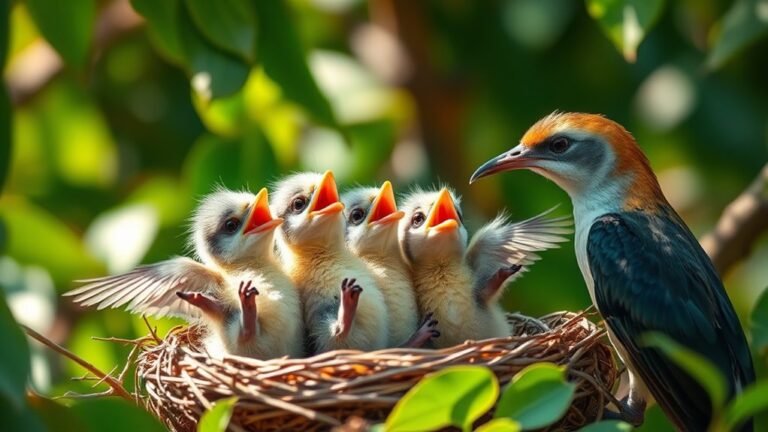Why Do Birds Chirp at Night? Understanding Nocturnal Vocalizations
Why do some birds chirp at night? These nighttime sounds serve important functions. Birds use their calls to attract mates and defend their territory. Each species has unique songs that adapt to the dark hours. This behavior raises interesting questions about how biology interacts with the environment. By studying these vocalizations, we gain valuable insights into bird behavior and ecology. Understanding why birds sing at night invites us to learn more about their world.
Key Takeaways
Nocturnal birds chirp at night mainly to communicate. They attract mates and establish their territory.
Male birds use specific calls at night to appeal to females. These calls show their strength and quality.
Environmental factors, such as moonlight and temperature, influence nighttime singing. Changes in these factors can affect how and when birds sing.
Urbanization poses challenges for nighttime birds. Noise pollution and habitat loss can disrupt their vocalizations and communication.
Different species, like the Common Nightingale and Eastern Whip-poor-will, have unique calls. These calls help define their identity and territory during the night.
Bird songs add to the night's atmosphere, making it lively and captivating. The tunes of nocturnal birds create an enchanting experience for those who hear them.
The Science of Birdsong: Understanding Vocalizations
Birdsong is an interesting behavior used mainly for communication. Birds produce sounds to convey messages. Some birds imitate sounds they hear in their surroundings or from other birds. This mimicry serves important purposes, such as improving their mating calls or marking territory. It helps them form social connections.
Each bird's song can vary. These variations help identify individual birds and indicate their familiarity with an area. A bird's unique song reflects its health and ability to adapt. This aids them in attracting mates and competing with rivals.
Understanding birdsong helps us appreciate the strong social structures in bird communities. It shows how vocalizations are crucial for their survival and interactions.
Species That Chirp at Night
Many birds sing during the day, but some species chirp at night. Their sounds create a captivating atmosphere.
These nighttime songbirds include:
- Common Nightingale – This bird is famous for its beautiful and powerful songs, especially in spring.
- Eastern Whip-poor-will – Its repetitive call echoes in various environments, marking the start of night.
- American Woodcock – Known for its unique "peent" sound, it produces a distinct rhythm at twilight.
- Yellow-billed Cuckoo – This bird makes a gentle cooing sound, adding to the night's musicality.
These nocturnal birds use their calls to communicate, attract mates, and define their territory in the dark.
Their songs highlight the adaptability and diversity of bird life.
The Role of Nocturnal Chirping in Mating Rituals
Nocturnal chirping is crucial for bird mating rituals. Male birds make specific calls at night to attract females.
These calls have unique sounds and patterns that help identify different species. Female birds listen carefully to these sounds to assess the strength and quality of a male's call.
At night, fewer rival males may be active, allowing the calls to travel farther. Learning about these nighttime displays helps us appreciate how birds effectively communicate to find mates under the night sky.
Territory Defense: Why Some Birds Sing After Dark
Birds use specific strategies to defend their territory, and some sing at night to enhance these efforts. Understanding their nighttime vocalization reveals important functions in territory defense:
- Less Competition: Many birds are silent at night, allowing a single bird's song to carry farther without interference.
- Clear Signals: The night air is often still, which helps sounds travel better. This clarity aids in territorial disputes.
- Safety from Predators: Singing in the dark can confuse predators while allowing birds to show their presence.
- Claiming Space: Nighttime singing helps birds mark their territory, decreasing the likelihood of encounters with rivals.
Environmental Factors Influencing Nighttime Vocalizations
As night progresses, various environmental factors can influence how birds vocalize.
One key factor is moonlight. Brighter nights encourage birds to sing more since they feel less exposed to predators. In contrast, during darker nights, many birds stay quiet to avoid danger.
Temperature also affects bird vocalizations. Warmer nights typically lead to more chirping. Birds have preferred temperature ranges for activity. A mild night creates a lively atmosphere, while cooler temperatures can lower vocalization rates.
Understanding these factors enhances your appreciation of the beautiful sounds of the night.
The Impact of Urbanization on Nocturnal Birdsong
Urban environments are lively, but they significantly affect nocturnal birdsong.
Urbanization changes how birds communicate in several ways:
- Urban noise hides the sounds of birds, making it harder for them to communicate.
- Light pollution disrupts their sleep cycles, changing when and how they sing.
- Habitat loss decreases nesting sites, increasing competition for space to sing.
- Invasive species may outcompete local nocturnal birds, changing the sounds heard at night.
These factors create a tough situation for nocturnal birds.
How Nocturnal Birds Adapt to Their Environment
Nocturnal birds have developed various strategies to adapt to their environments, particularly in urban areas.
They've improved hearing and vision to help them move, find food, and communicate at night. For example, owls are known for their excellent night vision and sensitive ears, which are crucial for hunting effectively.
These birds often have colors that blend in with their surroundings, providing camouflage in city landscapes. They adjust their calls to reduce interference from urban noise, ensuring they can communicate well during mating and marking their territory.
These adaptations highlight their ability to thrive alongside human developments and deepen our understanding of how birds survive in changing environments.
The Connection Between Predation and Nighttime Singing
Nighttime singing in birds serves important purposes related to survival. Understanding these functions can deepen your appreciation for these birds. Here are the main points:
- Predator Warning: Some birds use their calls to alert others about nearby predators.
- Territorial Defense: Singing at night helps claim territory and keep out intruders, which reduces fights in the dark.
- Attracting Mates: Calls can draw in potential mates and show off the singer's strength, which is vital for reproduction.
- Group Communication: Nocturnal singing lets birds signal safety or alertness to family members, enhancing their survival.
These actions highlight the various ways birds use their voices to thrive in their environments.
Enjoy listening to these fascinating creatures as they sing through the night!
Cultural Perspectives on Nocturnal Birds
Different cultures view the songs of nocturnal birds in unique ways, mixing feelings of respect and fear. Many people see these sounds as important symbols. They represent mystery and the border between life and death.
Folklore often links birds that sing at night, like owls, to omens or messages from the spirit world. In some cultures, their calls signal major life events or warn of danger.
Other groups feel that these songs bring peace and a connection to nature. By exploring these views, we can understand how nocturnal birds reflect both our fears and our awe, highlighting our deep ties to the natural world.
The Future of Nocturnal Birdsong: Conservation Concerns
As urban areas grow and climate change shifts our environment, the songs of nocturnal birds face serious risks. These issues need urgent attention:
- Urban development is reducing nocturnal habitats.
- Light pollution disrupts natural bird behaviors.
- Climate change is changing migration patterns and bird locations.
- Fragmented ecosystems limit food sources.
To protect these unique nighttime songs, strong conservation actions are necessary. We can protect and restore nocturnal habitats to lessen the effects of urban growth and climate change.
Support laws aimed at reducing light pollution and engage in local biodiversity efforts. By building community awareness around these problems, we can ensure that future generations enjoy the beauty of nocturnal birdsong.
Frequently Asked Questions
Do All Birds Sleep at Night?
Not all birds sleep at night. Their sleep patterns differ among species. Some birds rest during the day and are active at night. This behavior helps them adapt to their surroundings and find food. Understanding these patterns can help us appreciate the diversity of bird life.
Can Nocturnal Birds See Well in the Dark?
Nocturnal birds can see very well in the dark. They have special features that help them see in low light. Their larger pupils allow more light to enter their eyes. They also have more rod cells, which are sensitive to light. These adaptations help them find food and stay safe from predators at night.
How Can I Attract Nocturnal Birds to My Yard?
To attract nocturnal birds, set up bird feeders with seeds they like. Create a night garden using native plants that provide shelter and food. This will make your yard a welcoming place for these interesting birds. Enjoy watching them come to your yard!
Are There Specific Seasons When Nocturnal Chirping Is More Common?
Yes, specific seasons increase nocturnal chirping. This is often related to bird migration and breeding. During breeding seasons, birds tend to sing more at night. This behavior helps them claim territories and attract mates. Creating connections within their environment is essential for their survival.
Do Male and Female Nocturnal Birds Chirp Differently?
Male and female nocturnal birds chirp differently. Males often chirp to attract mates. Their calls are loud and varied. Females may chirp to defend their territory. Their sounds tend to be lower in volume and simpler. These differences reflect their roles in reproduction and survival. Understanding these chirps helps us appreciate their unique behaviors and adaptations.

Ava is a bird enthusiast and nature lover who has spent countless hours observing and learning about the fascinating world of birds. With a passion for sharing her knowledge and inspiring others to appreciate the beauty of birds, Ava writes about her experiences and insights on avianadmirer.com.







